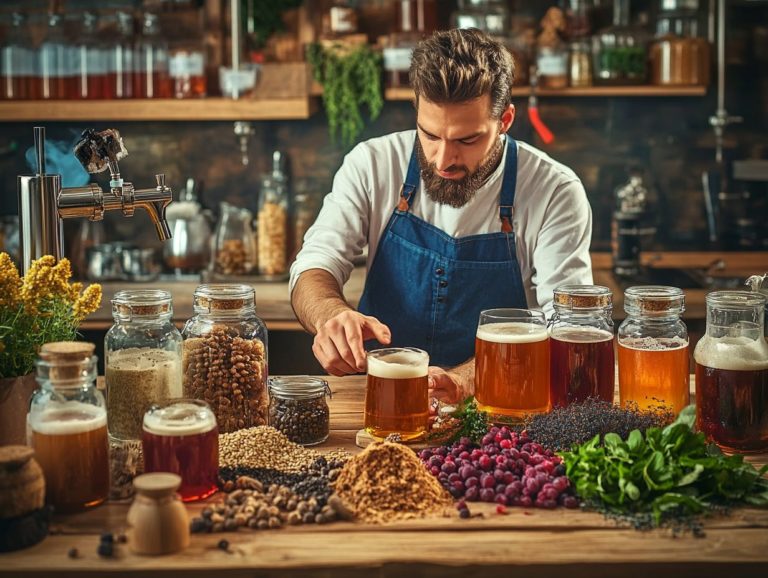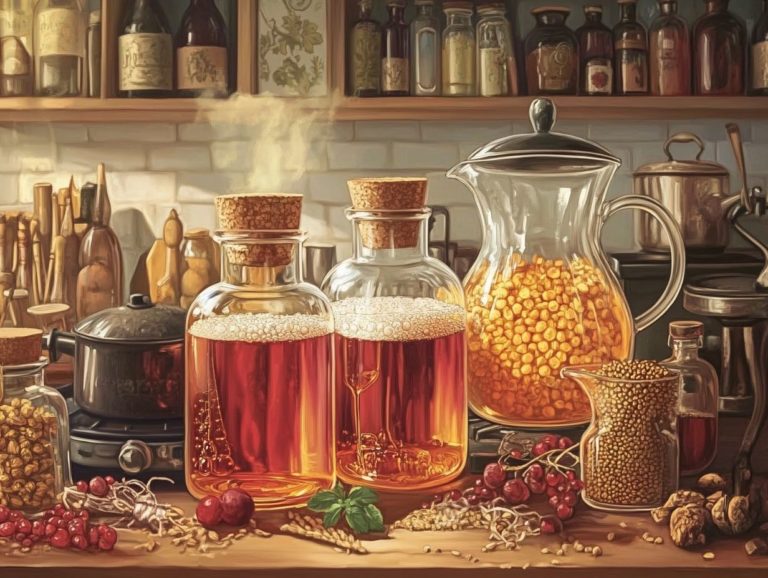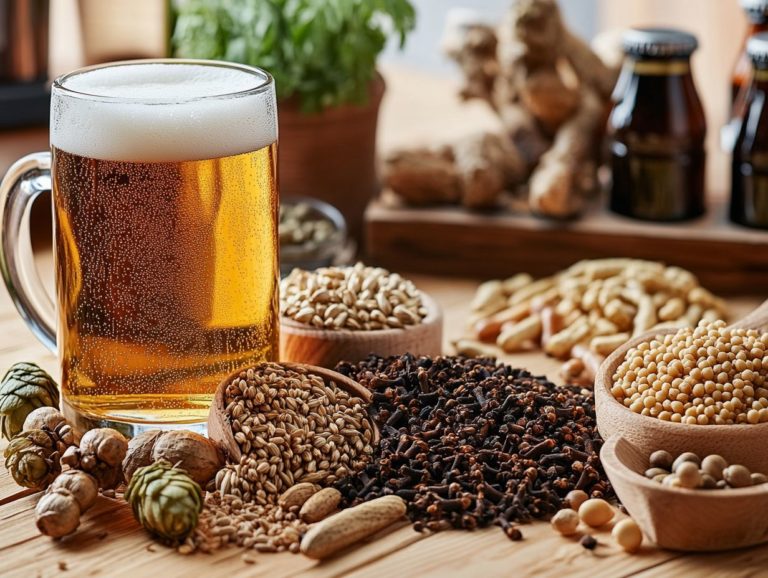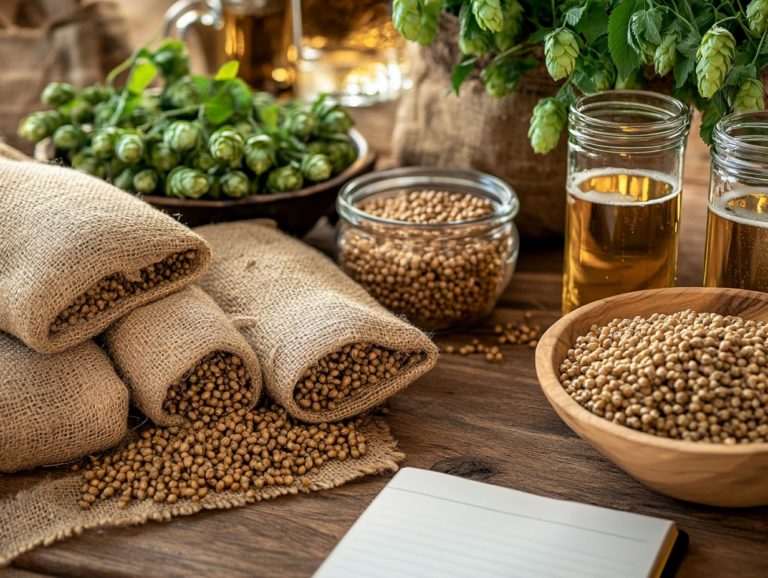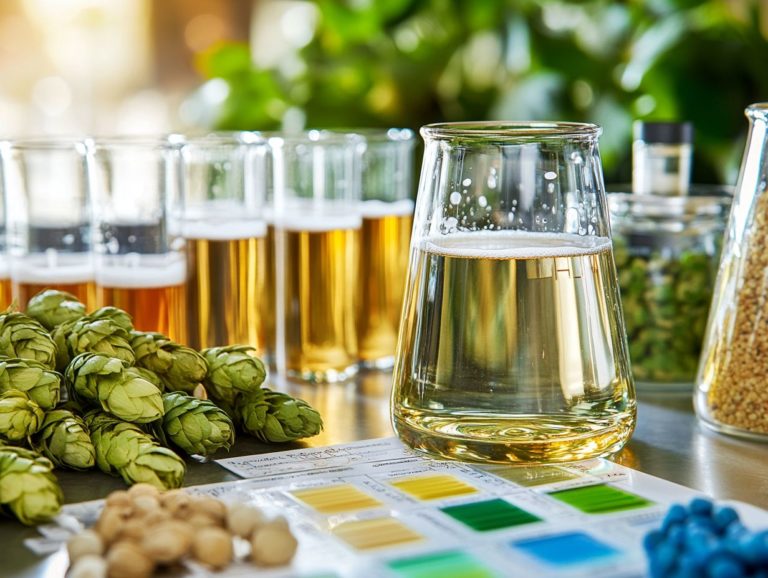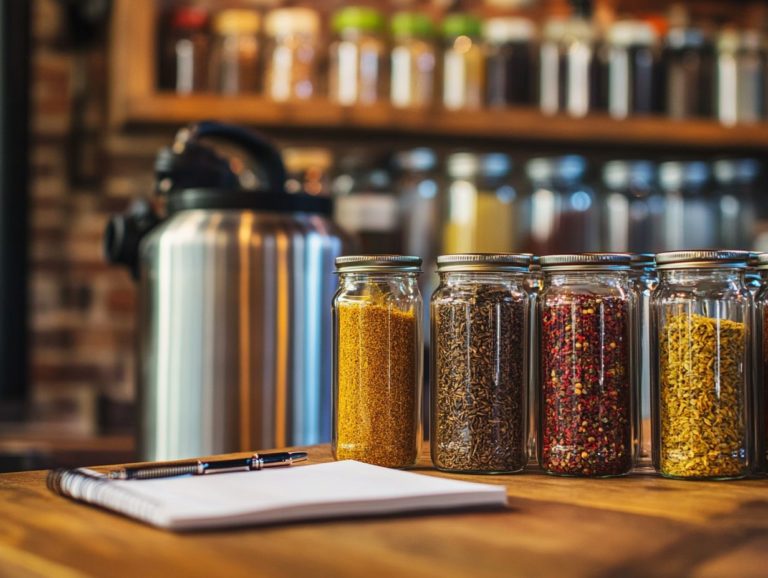5 Must-Try Additives to Elevate Your Beer
Crafting the perfect beer is truly an art form, and one remarkable way for you to elevate your creations is by experimenting with unique brewing additives!
From luscious fruit purees to rich coffee blends, these brewing additives have the power to transform ordinary brews into extraordinary experiences that tantalize the palate.
You re about to explore five must-try brewing additives fruit purees, coffee, spices, wood chips, and hops blends and discover how each one enhances the flavor, clarity, and complexity of your favorite beers.
Are you ready to take your brewing game to new heights? Let s get started!
Contents
- Enhancing the Flavor of Beer with Additives
- How Do These Additives Enhance the Flavor of Beer?
- Frequently Asked Questions
- What are the top 5 must-try brewing additives to elevate your beer?
- Why should I add fruit to my beer? Should I consider using yeast hulls?
- Can I use any type of fruit in my beer? Should I use Calcium Carbonate?
- How do spices enhance the flavor of beer? Can I use Super Ferment or Fermaid?
- What is the benefit of using hops as an additive in beer?
- What makes oak a unique additive for beer?
- Can I use lactobacillus with oak?
Key Takeaways:
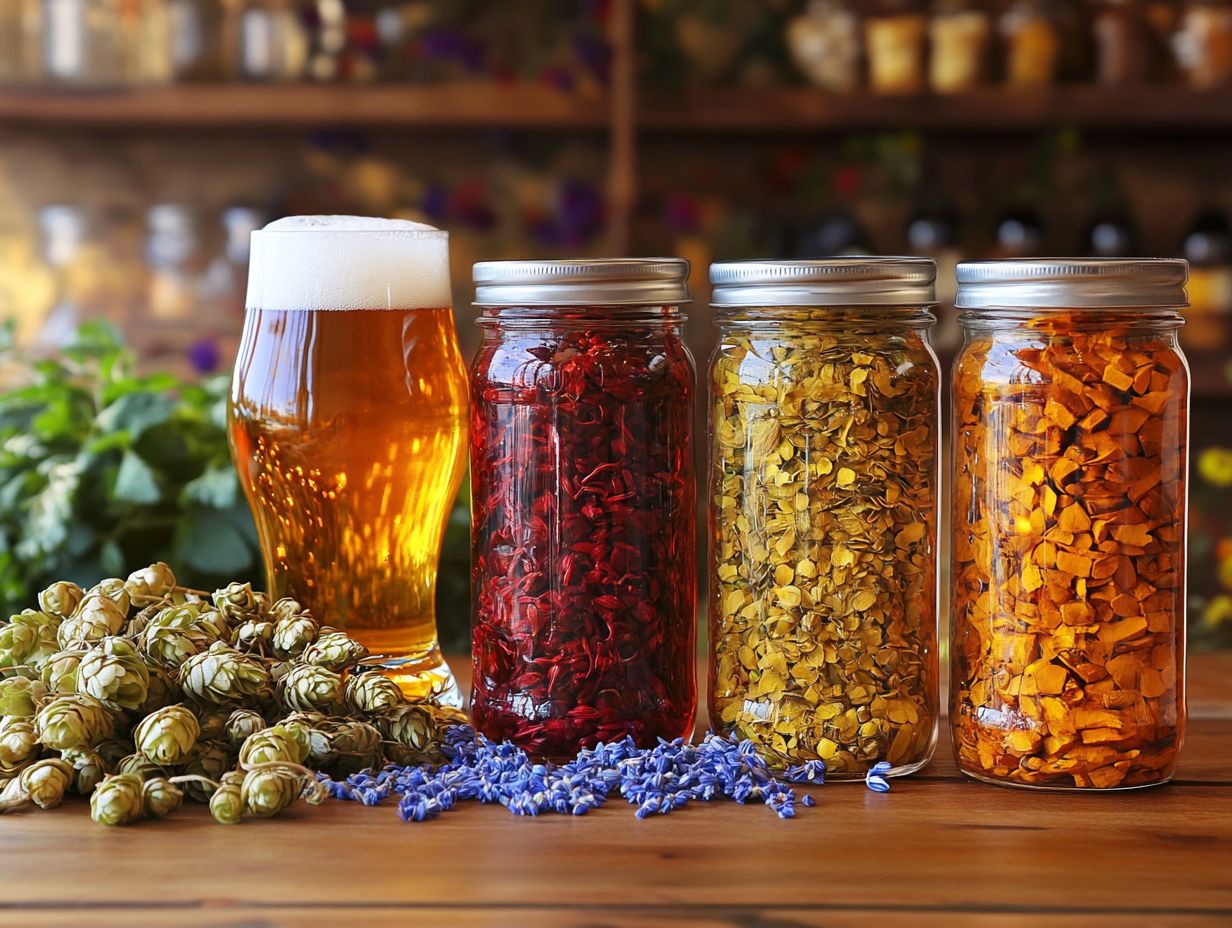
- Experiment with fruit purees to add a burst of natural flavor to your beer.
- Elevate your brew with the addition of coffee, which can bring depth and complexity to your beer’s flavor profile.
- Spice things up by incorporating spices into your brewing process for a unique and flavorful beer experience. Consider brewing with honey or crystallized citrus for added complexity.
1. Fruit Purees
In the realm of beer brewing, fruit purees stand out as a remarkable additive capable of significantly enhancing both the clarity and flavor profile of your beer.
When you incorporate these purees thoughtfully, they enrich the taste and infuse a vibrant hue that captivates the drinker s attention.
Selecting and applying the right fruit purees can positively influence fermentation performance, creating a delightful balance between sweetness and acidity.
By experimenting with various fruit flavors, you can craft unique styles, such as milkshake IPAs, while respecting traditional brewing processes.
Tropical fruits like mango, passionfruit, and pineapple offer a luscious sweetness combined with refreshing acidity, making them ideal for adventurous ales and sours.
On the flip side, berries such as raspberries, blueberries, and blackberries introduce tartness that beautifully balances maltier brews.
This interaction not only alters your brewing water profile by adding different minerals such as calcium carbonate or Burton Water Salts but also enhances mouthfeel and aroma.
For those focusing on styles like fruit-forward stouts or light-bodied summer ales, leveraging these purees can unlock a new world of complexity that resonates with many consumers.
Understanding how each fruit puree interacts with yeast and the overall fermentation conditions is essential for achieving your desired end result.
2. Coffee
The infusion of coffee into beer brewing has become a beloved trend among craft brewers, allowing you to experience rich chocolate flavors and a robust body that truly captivates your palate.
By integrating high-quality coffee into their creations, brewers can craft unique beer styles that not only highlight the coffee’s aromatic qualities but also elevate the overall flavor profile.
Whether you’re indulging in stouts, porters, or even IPAs, the careful selection of coffee beans and brewing techniques can profoundly influence the final product, offering you a diverse range of flavors and experiences.
Crucial to this process is your choice of roast level light, medium, or dark as it plays a critical role in achieving the taste you desire.
Light roasts often present fruity and floral notes, creating a brighter contrast with the beer, while darker roasts impart more pronounced chocolate and caramel flavors.
The origin of the coffee beans also matters greatly; beans from different regions bring unique characteristics to the table.
For instance, Ethiopian beans may introduce delightful berry-like flavors, while Sumatran beans can add a touch of earthy tones.
Finally, brewing techniques like cold brew or infusion experimentation during fermentation can further enhance the interaction between coffee and beer, allowing you to achieve a harmonious balance of flavors that tantalizes your taste buds.
3. Spices
Incorporating spices into your beer brewing process can elevate the profile of your craft beers, setting them apart from conventional varieties. This approach adds layers of complexity, enhancing the overall tasting experience with delightful nuances.
Spices like coriander, cinnamon, and ginger not only improve fermentation but also contribute unique aromas and flavors that engage the senses in a remarkable way. By experimenting with different spices during brewing, you can create signature beers that showcase your creativity and innovation.
The timing and method of adding these spices are crucial in shaping their impact on the final product. For instance, introducing spices during the boiling phase can amplify their flavors, while late additions just before fermentation help preserve their enticing aromas. Some brewers prefer using dry-spicing techniques post-fermentation, allowing the beer to retain a vibrant and fresh character.
Striking the right balance in quantity and timing is essential, as certain spices can easily overpower others. This illustrates the importance of precision in crafting a harmonious brew. Some brewers even incorporate exotic spices or peels to achieve unique profiles.
4. Wood Chips
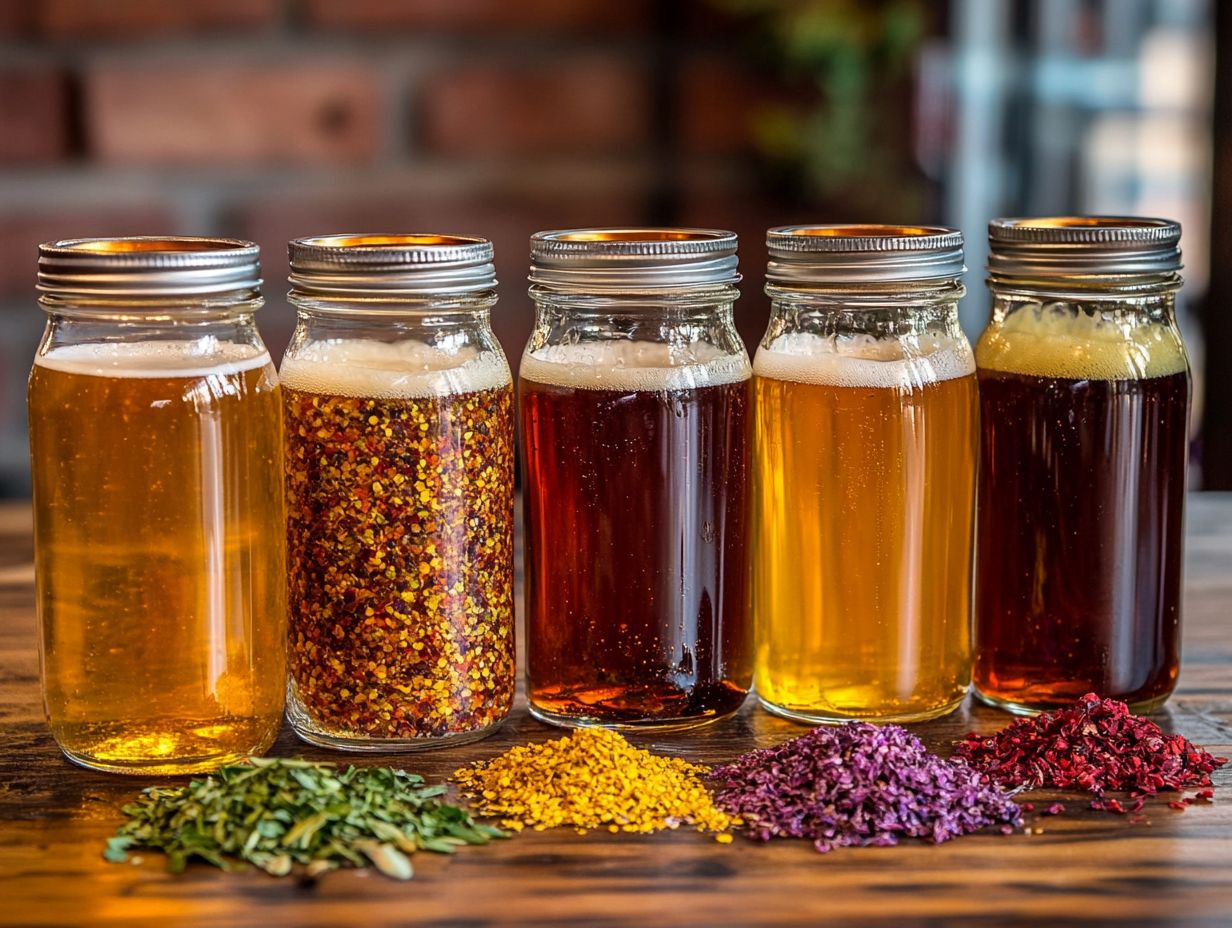
Utilizing wood chips, especially oak chips, in your beer brewing can elevate the flavor and complexity of your final product to extraordinary heights. These wood additives bring forth unique characteristics, such as enticing vanilla notes, toasty aromas, and even subtle hints of whiskey or wine, all depending on their treatment and origin.
By carefully selecting the right type of wood and managing the infusion process, you can craft beers that offer richer profiles and exceptional aging potential, ideal for adventurous palates ready to explore something special!
But don t stop at oak; there s a whole world of wood options to explore, including cherry, hickory, and maple. Each presents its distinct flavor profile. Cherry chips introduce a delightful fruity sweetness, while hickory lends a robust smokiness that can transform your brew. Exploring these options aligns with the innovative spirit of notable brewers like David Ackley.
Preparation methods are equally important. Soaking wood chips can help release essential oils that further enhance flavor integration. Meanwhile, toasting the chips beforehand introduces caramelization, adding yet another layer of complexity to your beer.
The choice of wood and preparation technique will shape your end product, allowing for an exciting array of flavors that can beautifully complement or contrast your beer’s inherent characteristics. Additionally, using additives like Irish Moss, gelatin, or isinglass can aid in clarifying your beer during the brewing process.
5. Hops Blends
Hops blends are essential in your beer brewing journey as they play an important role in defining the beer’s aroma, bitterness, and overall flavor profile. By skillfully combining various hop varieties, you can create harmonious flavors that elevate your beer, ranging from fruity and floral notes to earthy and spicy undertones.
The right hops blend not only enhances flavor but can also improve fermentation performance. Ensuring that your brewing water profile complements the selected hops is crucial for a balanced and satisfying final product.
Craft brewers like yourself often experiment with hops blends to achieve distinctive and memorable brews that truly resonate with consumers. The art of blending hops offers you a richer sensory experience and enables you to respond to market demands with unique offerings.
For example, blending citrus-forward hops with herbal varieties can create an inviting aroma that captivates enthusiasts. It s equally important to appreciate the role of brewing water chemistry in this intricate process.
Understanding how water composition interacts with different hops can significantly influence the extraction of desired flavors and aromas during brewing. Factors like pH levels (which indicate acidity), mineral content, and sulfate-to-chloride ratios (which affect flavor balance) are critical in determining how well your chosen hops perform during fermentation. Highlighting the intricate relationship between hop selection and water chemistry is essential in crafting exceptional beers.
Enhancing the Flavor of Beer with Additives
How Do These Additives Enhance the Flavor of Beer?
Using brewing additives like fruit purees and spices can truly elevate your beer s flavor and character. These ingredients craft a multi-dimensional tasting experience that captivates any enthusiast. Each additive plays a unique role, influencing both the brewing process and how yeast works during fermentation, while inviting you to explore a vast landscape of flavors that challenge traditional styles.
Understanding how these elements work together allows you to create distinctive beers that reflect your creativity. You can also cater to the ever-evolving preferences of beer drinkers. Utilizing supplements like Fermaid, yeast hulls, or super ferment can further enhance your brewing performance.
For example, adding fruit purees introduces a refreshing acidity and vibrant aroma, significantly enhancing the overall complexity of the beer. Coffee and spices contribute depth to the mouthfeel and aroma, layering flavors that narrate a delightful story with each sip. Wood chips bring subtle tannins and vanilla notes, setting a specific mood for your beer that often aligns with seasonal themes.
Each brewing additive is like a secret weapon in your brewing arsenal! It allows you to refine your craft and experiment with balance, ensuring that the final product is not only intriguing but also thoroughly enjoyable. For instance, incorporating cacao nibs or lactose can create a rich and creamy mouthfeel.
What Are the Different Types of Fruit Purees That Can Be Used, and How Do They Affect Fermentation?
When you delve into brewing with fruit purees, you’ll discover an impressive array of options, inviting you to explore diverse flavors that can elevate your beer offerings to remarkable new heights. From beloved classics like raspberry and blackberry to intriguing blends featuring crystallized citrus or exotic tropical fruits, each puree imparts unique characteristics that enrich the overall flavor, clarity, and aroma of your beer.
Choosing the right fruit puree enhances how well the yeast works during fermentation, creating a harmonious balance between sweetness and tartness that complements the other ingredients in your brewing processes, including the brewing water profile.
Imagine the vibrant infusion of a peach puree adding juicy sweetness to a wheat beer, or picture a zesty passionfruit puree enhancing an IPA with bold tropical notes. Meanwhile, purees made from cherries or currants introduce delightful tartness to stouts and porters, enriching the beer flavor even further.
The integration of fruit purees can occur at various stages throughout brewing from primary fermentation to conditioning allowing you to control the fruit flavor’s impact meticulously.
By grasping how these purees interact with yeast and hops, you can craft beers that beautifully showcase both the natural essence of the fruit and the intricate artistry of brewing techniques.
What Are the Best Types of Coffee to Use in Beer?
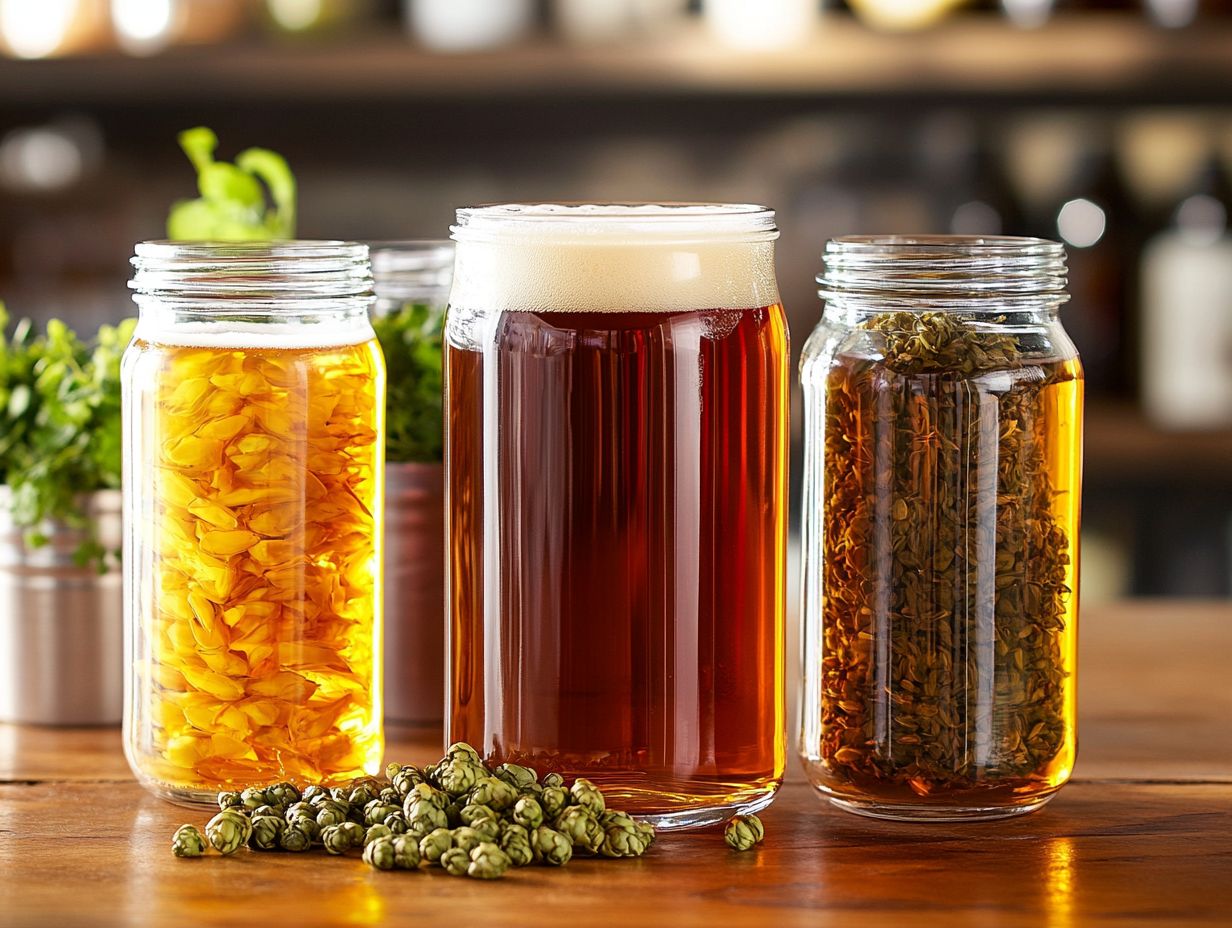
Choosing Coffee for Beer
Selecting the right types of coffee for brewing beer is essential. The beans you choose can significantly impact the beer’s flavor profile and overall character.
Good coffee types, like Ethiopian and Brazilian beans, deliver unique flavor notes that range from rich chocolate undertones to vibrant fruity highlights. This makes them perfect for a variety of beer styles, including milkshake IPAs.
By understanding the roasting process and employing the right brewing techniques, you can elevate the coffee infusion, allowing your brew to showcase the depth of coffee without overshadowing the other ingredients in your beer.
Feel free to experiment with different roasting levels; this can produce a delightful spectrum of flavors. From the bright acidity of lightly roasted beans to the deep, bold richness of darker roasts, the possibilities are exciting.
For example, a medium roast could lend a sweet caramel flavor that beautifully complements a stout, while a dark roast might introduce a robust smokiness that pairs wonderfully with porters. Adding brewing additives like cacao nibs can further enhance these flavors.
To strike the perfect balance, consider various methods of incorporating coffee, whether adding it during the mash or during secondary fermentation. This careful approach can create a delicious brew that everyone will enjoy.
Experimenting with brewing with honey can also add a unique dimension to your coffee-infused beer.
How Can Spices Be Incorporated into Beer?
Incorporating spices into your beer brewing demands a thoughtful approach, as the timing and method of addition can dramatically influence the beer’s flavor and aroma. You have the opportunity to experiment with an array of spices, such as cinnamon, coriander, and ginger, to elevate fermentation performance and craft unique flavor profiles that cater to diverse palates.
By grasping the characteristics of each spice and how they interact with the other ingredients in the brewing process, you can create beers that truly stand out in both aroma and taste.
The timing of your spice addition is crucial. While some spices reveal their magic best during the boil, allowing their essential oils to be extracted, others shine brighter when introduced during fermentation or even at bottling. This technique enables you to achieve more nuanced flavors without the risk of overwhelming the brew.
For example, when you add spices early in the boiling process, they impart a more integrated flavor. In contrast, later additions a common practice in brewing wheat beers or holiday ales tend to provide a brighter, more pronounced aroma. Striking a harmonious balance can be a delicate endeavor; improper measurement or timing might lead to overpowering flavors that mask the base ingredients of your beer, ultimately detracting from the intended profile.
Using brewing additives like Irish Moss and Gelatin, which help clarify the beer, can also improve beer clarity when adding spices.
What Types of Wood Chips Are Recommended for Beer?
The choice of wood chips in your beer brewing can significantly shape the final flavor and aroma. Oak chips are a favored option for their ability to impart sophisticated nuances. Exploring different types of wood, such as cherry and hickory, can unlock unique flavor profiles that enhance the complexity and depth of your brew.
David Ackley recommends experimenting with various types of wood to achieve the desired profile. By familiarizing yourself with various wood types and the techniques for their incorporation, you can create innovative beers that elegantly showcase the interaction between wood and other ingredients while maintaining a balanced flavor experience.
Utilizing calcium carbonate in your brewing processes can help adjust the brewing water profile when using wood chips. For instance, cherry wood chips can impart a delightful, sweet, fruity essence, while hickory brings a smoky richness that beautifully complements darker beers.
Many brewers opt to soak wood chips before use, hydrating them to help release subtle flavors during the brewing process. Toasting the chips can elevate their inherent qualities even further, adding layers of caramel or vanilla notes that enrich your creation.
Utilizing infusion methods, which are techniques where chips are added during fermentation or aging, allows for a gradual development of flavors. This enables you to craft distinct profiles that resonate with your target audience and elevate the overall drinking experience.
Using brewing additives like ascorbic acid and yeast nutrient can refine your techniques. Give these wood chip varieties a try in your next brew and taste the difference!
What Are the Benefits of Using Hops Blends?
Using hops blends in your beer brewing opens up a world of possibilities. This allows you to create complex flavor profiles that cater to a diverse array of palates. By skillfully combining different hop varieties, you can enhance the bitterness while infusing aromatic qualities, resulting in a truly well-rounded beer experience.
These blends not only improve fermentation performance but also help you achieve a harmonious balance in the brewing process. They are an essential tool in the craft brewing realm. Experiment with brewing additives like Burton Water Salts and Gypsum to further refine your hops blends.
These blends enable you to craft beers with distinctive characteristics, showcasing unique floral notes from specific combinations or vibrant citrusy and piney aromas from others. For example, a classic Cascade and Centennial blend can work wonders in American Pale Ales, delivering robust bitterness alongside zesty scents.
Similarly, mixing Citra and Mosaic is a go-to choice for IPAs, unveiling delightful tropical flavors. The versatility of hops blending not only elevates your sensory experience but also sparks innovation, encouraging you to experiment with various styles like lagers or sours.
This adventurous spirit ultimately enriches the entire brewing community, creating a tapestry of flavors and experiences for everyone to enjoy. One interesting challenge in this experimentation process can be adhering to the Reinheitsgebot purity law.
Frequently Asked Questions
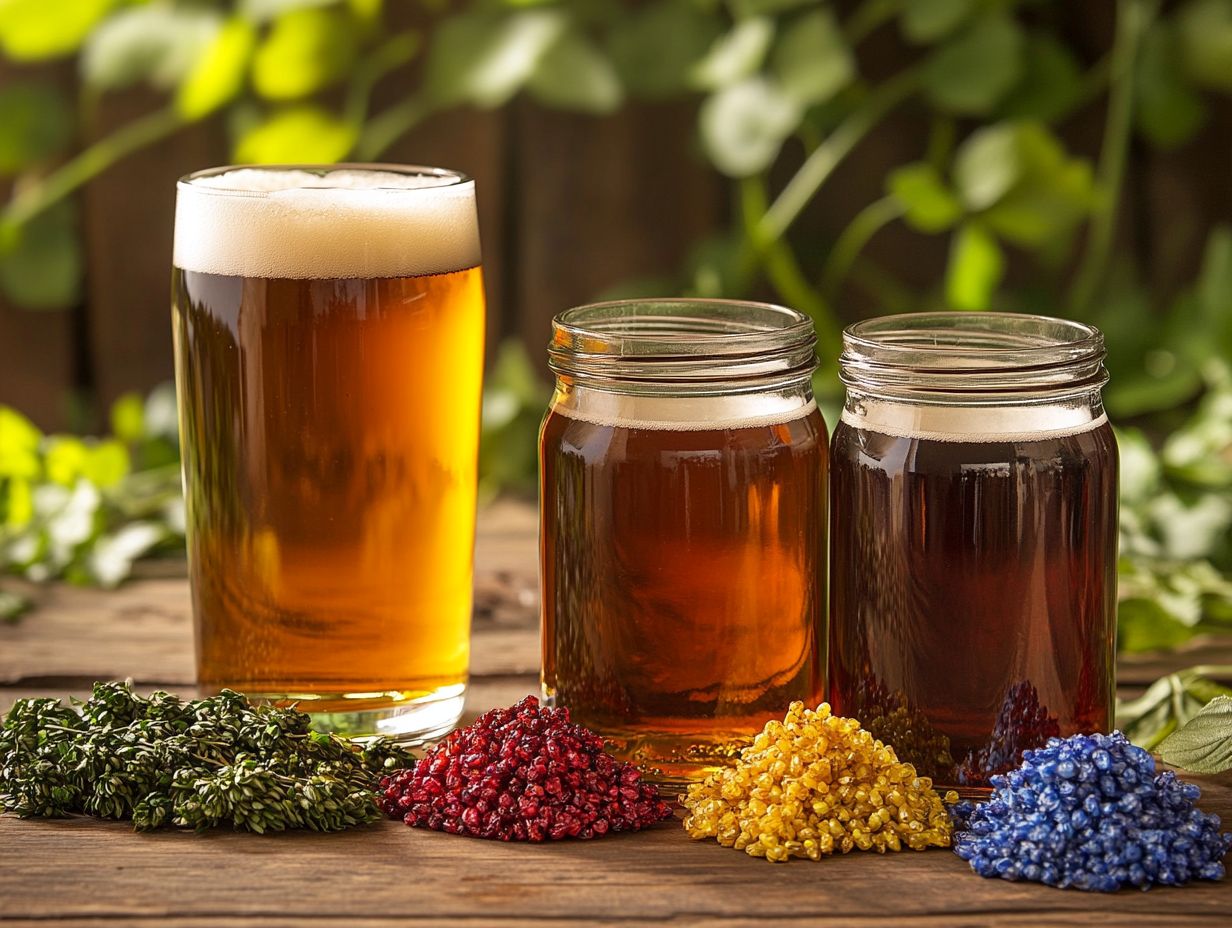
What are the top 5 must-try brewing additives to elevate your beer?
- Fruit
- Spices
- Hops
- Oak
- Lactose
Using brewing additives like ascorbic acid and yeast nutrient can also enhance the quality.
Why should I add fruit to my beer? Should I consider using yeast hulls?
Fruit adds a refreshing and natural sweetness to your beer, making it more enjoyable to drink. Considering additives like yeast hulls can improve fermentation performance when adding fruit.
Can I use any type of fruit in my beer? Should I use Calcium Carbonate?
Yes, you can use any type of fruit depending on your personal preference. Some popular fruits to add to beer are berries, citrus fruits, and tropical fruits.
Experiment with crystallized citrus or fruit peels for a unique twist!
How do spices enhance the flavor of beer? Can I use Super Ferment or Fermaid?
Spices add complexity and depth to the flavor of beer, making it more interesting and satisfying to the palate. Using Super Ferment or Fermaid can help balance these flavors during the brewing process.
What is the benefit of using hops as an additive in beer?
Hops bring an exciting bitterness that perfectly balances the sweetness of your beer. They also contribute to the aroma and flavor, creating a more well-rounded and flavorful brew.
What makes oak a unique additive for beer?
Oak adds a woody, vanilla, and sometimes smoky flavor to beer. It is reminiscent of barrel-aged beers and helps to mellow out the flavors for a smooth finish.
Can I use lactobacillus with oak?
Using lactobacillus with oak introduces a delightful sourness. This sourness complements the oak’s characteristics beautifully.
Discover the unique flavors that hops and oak can bring to your next brewing adventure!

